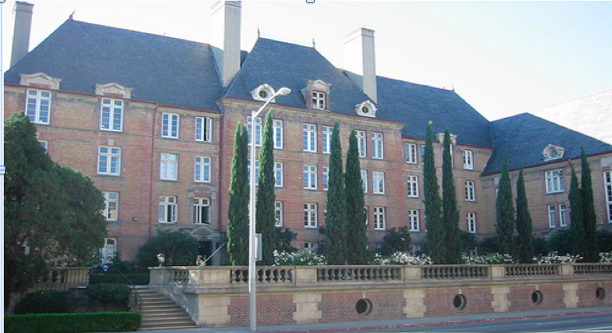
Who hasn’t marveled at the classic sophistication of high-rise housing located along the Fountain Avenue and Crescent Heights corridors? Designed to the highest architectural standards, these buildings were built in the 1920s and 1930s when an early and growing motion picture industry encouraged luxury housing close to Hollywood studios.
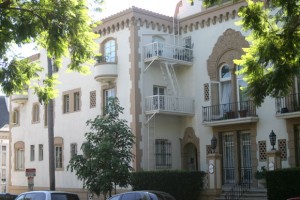
Their period revival styles and large courtyards created something unique to the community and to the region: large-scale, multi-family housing. They also established an architectural character that still defines the city. A simplistic explanation for their success could be called “density done right” – the cornerstone of how movies transformed West Hollywood forever.
But wait – A check of 20 primary buildings along those historic corridors shows that at least 14 were built before or during 1928. That’s when Los Angeles County authorities enacted zoning laws for the first time in the unincorporated community of West Hollywood.
How is it possible, you ask, that high-density housing – something new to the area – could be done so well without the wisdom and guidance provided by a zoning ordinance? This situation is best explained by taking a look at “population density” from a historical perspective. Population density is defined as the number of people per square mile within a city’s boundaries.
West Hollywood has one of highest density rankings not only in Los Angeles County but also in California and in the United States. With 18,297 people per square mile, according to 2010 U.S. Census Bureau data, West Hollywood ranks as the:
- 4th most densely populated city in Los Angeles County,\
- 4th most densely populated city in California, and
- 17th most densely populated city in the United States.
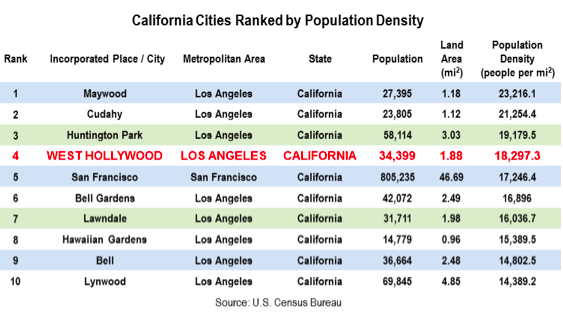
Or, as Elvis might say, “a whole lot of density goin’ on.” And it has been “goin’ on” dating back almost to the founding of Sherman, a town that became known as West Hollywood in 1925. The community had to respond quickly to explosive growth by electric streetcars and motion pictures – and to being hemmed in by the city of Los Angeles. Multi-family housing was a solution at a time when surrounding communities expanded ever outward with large tracts of standalone homes. High-density housing would set the community apart from others in more ways than one.
BLAME THESE GUYS
“The city of West Hollywood today owes its existence to one of Southern California’s first interurban electric railways, the Pacific and Pasadena (aka Los Angeles Railway),” proclaimed KCET, the country’s largest independent public television station, on the occasion of West Hollywood’s 30th cityhood anniversary in 2014. “On Nov. 29, 1984, the town born of a rail yard became the City of West Hollywood,” the Los Angeles-based station stated in summarizing the city’s humble beginnings.
Assembled in the 1890s by Moses H. Sherman and his brother-in-law Eli P. Clark from failed and fragmentary predecessors, the Pasadena and Pacific connected the booming city of Los Angeles with the beach town of Santa Monica.
They based the railways’ main shops, railroad yards, power plant and “car barns” at roughly at the midway point, or where Santa Monica and San Vicente boulevards intersect today. The introduction in 1896 of a water delivery system by John Pirtle’s West Los Angeles Water Company made more intensive development possible, sending the town of Sherman, as it was modestly named by Sherman and Clark, well on its way to becoming a crossroads of local development.
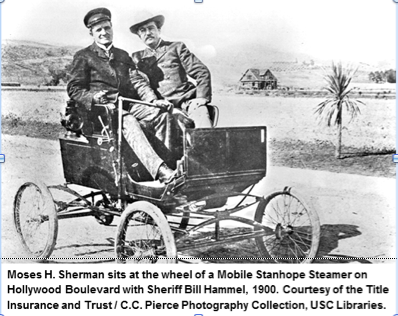 They platted a small town adjacent to the rail yard so workers could live close by. Residential lots sold for $150 and were available for a $10 down payment with $10 monthly payments to follow. Modest wood frame homes and Craftsman-style bungalows began appearing. Soon, a small working-class town sprouted, populated by railroad workers and their families.
They platted a small town adjacent to the rail yard so workers could live close by. Residential lots sold for $150 and were available for a $10 down payment with $10 monthly payments to follow. Modest wood frame homes and Craftsman-style bungalows began appearing. Soon, a small working-class town sprouted, populated by railroad workers and their families.
In 1910, there were some 900 residents serviced by a small commercial strip along Santa Monica Boulevard. Another measure of how quickly business grew: The railway operated 221 cars in 1905, which increased to 813 cars by 1921.
SHERMAN IS A STAR OF MOTION PICTURES
The growth of the entertainment industry also had a profound and simultaneous impact on Sherman. The film business
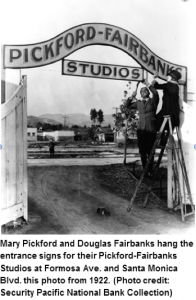 was going gangbusters in the first decades of the 20th century, when the arrival of newcomers and tourists fueled the need for temporary and long-term rental housing.
was going gangbusters in the first decades of the 20th century, when the arrival of newcomers and tourists fueled the need for temporary and long-term rental housing.
Movie crews arrived for the first time in 1916, not quite 10 years after the industry’s birth in Los Angeles. Four years later, Union Film Company set up shop as Sherman’s first permanent film company. Both the United Artists Studios, founded in 1919, and the Silent Dramas Syndicate established themselves in Sherman. Also in 1919, Jesse D. Hampton created a full-fledged studio at Formosa and Santa Monica Blvd. The studio would become known as Mary Pickford Studios, United Artists, Warner Hollywood and now simply, The Lot.
In addition to housing, Sherman served as a significant production center. The studio on Santa Monica Boulevard was used continuously while the town itself became a backdrop for location filming. Supporting industrial facilities, such as the Mitchell Camera Company, also flourished in West Hollywood.
And it didn’t hurt either that during the Prohibition era, the community began earning a reputation as a liquor-friendly, loosely regulated place for eccentric people wary of government interference – the beginnings of an independent streak that runs through the city to this day.
DENSITY AS A BIRTHRIGHT
Put it all together and it meant that Sherman, and later West Hollywood, would be densely populated almost from inception. Density was something of a birthright, for all practical purposes – or as Hamlet might have said, “Density – thy name is West Hollywood.”
Sherman’s population boomed beginning in 1922, reaching 20,000 by 1930. By 1940, the community was largely built out – and most development since then has been in-fill. Population would grow incrementally after that, reaching 28,870 in 1960.
While Sherman embraced small, single-family homes in the beginning, it soon broke out of that mold when the city of Los Angeles began hemming it in by annexing several large but mostly vacant tracts surrounding the town. Sherman’s development bumped up against L.A.’s city limits, but independent-minded civic leaders resisted pressure to be annexed. Without a great deal of open land on which to expand, multi-family housing became the only alternative.
A migration away from single-family homes began in the 1930s and became a full-scale exodus in the 1950s, resulting in the construction of a wide variety of sizes and types of apartment buildings. West Hollywood was well on its way to being a city of apartment dwellers. Today, 78 percent of the city’s residents are renters.
WE’RE HERE, WE’RE DENSELY POPULATED, GET USED TO IT
Higher-density developments met an urgent need for worker housing close to employer locations in all industries – and set West Hollywood apart in an important way: While surrounding cities and communities developed predominately in a pattern of traditional single-family neighborhoods, West Hollywood filled the local need for apartment, rental and short-term housing.
The housing mindset was further distinguished later on by integrating low-and high-density housing on the same streets – a phenomenon at the time but later more or less formalized when zoning was put in place in 1928. Los Angeles apartment housing, in contrast, tended to cluster along major boulevards and thoroughfares with single-family neighborhoods filling in the blocks between.
Some of the most striking apartment houses would be built along Fountain, Harper, Crescent Heights and Havenhurst north of Santa Monica Boulevard. Designed by renowned architects such as Leland Bryant and Arthur and Nina Zwebell, these sophisticated, high-rise buildings created an impressive streetscape. They gave West Hollywood an architectural heritage recognized worldwide, as noted by the by the National Trust for Historic Preservation, when it named West Hollywood one of America’s “Dozen Distinctive Destinations.”
ECONOMIC MUSCLE TO SPARE
How could West Hollywood carve out a housing direction so different from that of its neighbors – especially when two of the government’s largest domestic spending programs in the 1940s and 1950s that affected housing bypassed the community altogether? Basically – West Hollywood served a market others more or less ignored.
First, the Veterans Administration’s home loan program kicked in after World War II ended. Low-density, residential construction spread even faster. But those loans had little effect on West Hollywood, which was putting all of its eggs in the multi-family basket to meet pressing needs in its own backyard.
Second, when the region’s freeway system was built in the 1950s, single-family home construction shifted into overdrive elsewhere. The new freeways, of course, provided no additional or special value to West Hollywood. It was far along on its own “road to bountiful,” growing through infill development with new, larger and distinctly modern multi-family properties.
That’s when all manner of apartment houses proliferated in the community – duplexes, flats, courtyard housing, bungalow courts, garden courts, stucco box and other multi-story buildings were sprinkled everywhere there was a place to put them.
ONLY IN WEST HOLLYWOOD
Zoning is a subject that usually has all the excitement of watching the robo-garage construction cam. But it took its own unique twists and turns, especially after incorporation in 1984. Zoning laws were used to shut down a group of four bondage clubs in 1985 that were operating in residential neighborhoods. The clubs were locked in a vicious competition for new customers and apparently upsetting neighbors with aggressive recruitment tactics.
And maybe only here, with a large population of lesbian, bisexual, gay and transgendered residents, would the city council find itself defending zoning laws against charges they discriminated against heterosexual families, which was another well-publicized situation in 1985. http://search.proquest.com/docview/292134142/275FB986900D4484PQ/6?accountid=35804
THE LIGHTER SIDE OF A HEAVY ISSUE
Density is not without its lighter moments – especially back when many celebrities with hyper-active social lives lived close together in the classically designed apartment buildings in the Harper Avenue Historic District. For example:
Bette Davis lived in the Colonial House Apartments, 1416 Havenhurst, near the end of her career in the 1980s. Her neighbor just happened to be softcore porn star Sylvia Crystal (Emmanuel, 1974). Davis reportedly told all of her friends that she “lived next door to a hooker.”
Charlie Chaplin kept an apartment at Patio Del Moro, 8225 Fountain Ave., and also was said to rent apartments in the building for girlfriends. At the time, there was a tunnel from Chaplin’s kitchen past the boiler room that led to Paullette Goddard’s kitchen.
Cary Grant moved into the LaRonda Apartments, 1400 Havenhurst, with Virginia Cherill after their Feb. 1934 marriage. But when his ex, Randolph Scott, moved next door, she flipped out and divorced Grant in March 1935.
Bob Bishop is a recently retired public relations manager in the aerospace industry who has lived on North Kings Road for more than 20 years. Previously, he was public information officer for the California Manufacturing Technology Consortium, a public-private partnership to improve the quality and productivity of the state’s small manufacturers. A former professional journalist, Bishop was Los Angeles bureau chief for the former Electronic News, a national trade paper for the semiconductor and computer industries. Prior to that, he was a daily newspaper reporter for the Sun-Herald in Gulfport-Biloxi, Miss.

Folks – We are talking about density within the specific boundaries of an incorporated CITY and NOT a neighborhood. There IS a difference ! !
“Higher-density developments met an urgent need for worker housing close to employer locations in all industries – and set West Hollywood apart in an important way: While surrounding cities and communities developed predominately in a pattern of traditional single-family neighborhoods, West Hollywood filled the local need for apartment, rental and short-term housing.” I always enjoy reading the history of our City. Unfortunately, one problem that we are facing now is that the higher-density developments are not meeting needs for worker housing – the prices are too high for most regular workers. And really there are no jobs being created where… Read more »
Not necessarily DD – the average occupancy of our residences (# of people living in a unit or house) seems to be going down (1 person now living where 2 did, 2 when there were 3 roommates) as a different demographic moves in.) When it stays the same or goes up, it could be because of children, less demanding in terms of crowdedness issues, and traditionally a low level of WeHo’s population. I expect the city’s population – and thus density – to stay b/w 35,000-37,000 for a long time. Density of population in terms of increase should be just… Read more »
Interesting article. However, I concur with Romanoff that talking about WeHo as the “fourth densest city” creates a distorted impression. It’d make more sense to compare WeHo to a similarly sized parcel of land than entire vast cities that include widely varying density, and includes mostly uninhabited canyons and mountains. Despite being the fourth densest “city,” West Hollywood is only the 18th densest neighborhood in the region, according to the LA Times, and several others are very close to our density: http://maps.latimes.com/neighborhoods/population/density/neighborhood/list/ Koreatown is more than twice as dense, and Westlake and East Hollywood are more than 1.5 times as… Read more »
agrees with romanoff
Illuminating article. Only problem is if over-development continues at the current rate, WeHo will assuredly be #3 (or higher) before too long. This is especially true since some members of the Planning Commission are in favor of even TALLER residential buildings (read million dollar condos), destroying single family homes, using the dreaded Ellis act to evict long term residents who must find housing outside of WeHo, etc., etc. etc.
Great article! And Im told by long time neighbors Cher lived on Huntley Drive! at my house!
This is ridiculous. The “city” is 1.9 square miles in the middle of Los Angeles. Of course it appears dense….but draw a line around nearly any 1.9 square mile area in the central city and it will look the same if not worse.
Yes of course we’re a City, and I’m glad we are, but really we’re just an artifically created geographic area within Los Angeles that due to politics IS a City.
Density isn’t really an argument for or against development.
Great article .I’ll take a dozen of those $150.00 lots!
Only one mistake was noted. The Pacific and Pasadena became the Pacific Electric which was owned by Henry Huntington. He also owned the narrow gauge Los Angles Railway. Huntinton lost control of the Pacific Electric to the Southern Pacific headed up by his uncle Harriman. Huntington remained owner of the LARW until his death and it was ultimately sold to National City Lines and became Los Angeles Transit Lines. And that is how we got the MTA Division 7, a former P.E. rail yard.
Terrific article Bob, both for its history and for giving context for the current realities of WeHo.